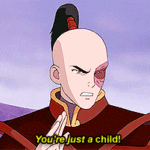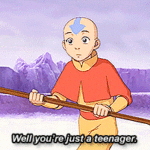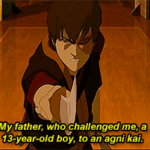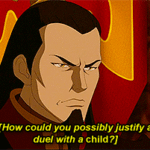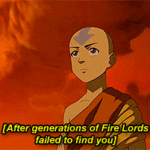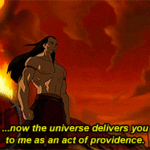Inspired by (x)
Thanks, friend.
The Avatar Returns: Zuko kind of mimicking his father.
The Day of Black Sun: Zuko realizing that not only was he in the wrong, but that his father was really in the wrong and absolutely fucked up for dueling, scarring, and banishing him.
Sozins Comet: Ozai being a fucked up asshole as usual by indiscriminately attacking children without second thought and mistaking mercy for weakness.I while back, I mentioned wanting to make this gifset and not having the technical skills, and @renaisty was kind enough to go ahead and make this for me. (Thank you!) Anyway, I’m so happy this gifset exists, because it perfectly illustrates one of the themes of Avatar: the Last Airbender, the idea that fighting children is wrong.
I’m pretty sure you read the last sentence and thought, “Well, yeah, sweetie, that’s obvious.” It’s pretty well universally acknowledged by anyone who isn’t a morally bankrupt warlord that putting children in combat is one of the most despicable things you can do. However, it does make Avatar: the Last Airbender an oddball in its own genre of children’s adventure fantasy. Children’s adventure fantasy, a genre in which children fight in wars, battle evil and save the world, is a power fantasy, and it’s no surprise that children, who have very little power in society, would enjoy it. It gives them a safe and enjoyable way to explore what it might be like to have power, and what they could or should do with it. So the adults who understand this and who have chosen to write adventure fantasies about and for children by and large put the issue of children in combat on the back burner. It gets in the way of the fantasy, so they ignore it with a wink and a nod. Avatar: the Last Airbender doesn’t do that. It actually engages with its premise.
The Avatar world has a lot of children in combat. All of the main characters and a fair chunk of the antagonists and side characters are children fighting a global war. The main character is a super-powered child savior. There are plenty of opportunities here for the kind of vicarious use of power that makes children’s adventure fantasy so much fun. However, wherever there is a child in combat in the Avatar universe, there is a child in pain, who is hurting very badly because of it, and wherever there is a child in combat in the Avatar universe, there is an adult who has somehow forced them into this. This willingness to engage with the story’s own premise, and to deal intelligently with the moral issues therein gives a greater depth and sense of reality to the Avatar universe.
Crucially, the argument against children in combat that Avatar: the Last Airbender makes isn’t that children are incapable of fighting and winning, it’s that fighting a war damages them. Two of the strongest characters on the show, Aang, by far the most physically powerful being on the show, and Azula, a fighting and military prodigy, and one of the most dangerous and effective villains in the entire franchise, are children, and both of whom suffer terribly because they are in combat. Aang suffers nightmares, anger, and feelings of helplessness and guilt, while Azula’s experiences of living under the domination of the kind of man who would send her to war help fuel her breakdown. This is one more way in which Avatar: the Last Airbender consistently shows that moral choices, doing wrong, has consequences, and that these consequences are all too often borne by people other than the one making the choice.
The main villain of the show, Ozai, is shown to be a thoroughly reprehensible human being in so many ways throughout the show’s run, but the first time the audience sees him, it’s performing a very specific horrible act, forcing his thirteen year old son to fight. This is where we first see what Ozai is capable of, where he goes from being a villain because he is the leader of the Bad Guys, to being a villain because he does horrible evil things that hurt other people. This becomes a theme for Ozai, and one of the last evil acts we see him perform is fighting another thirteen year old. The fact that this is the way we meet Ozai, and the way we leave him leaves the impression that of all the things that make Ozai evil, his willingness to fight children and force children to fight is one of the most evil.
This is a powerful message in a show for children, that it doesn’t matter how capable a child is, they deserve to be protected by the adults in their life, and an adult who puts them in danger isn’t showing faith in their abilities, but is instead hurting them by denying them the safety they deserve.
Bringing this back because I saw a photoset going around that manages to miss the point that the kids in AtLA are profoundly negatively effected by being child soldiers.

Just another WordPress site
